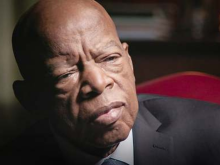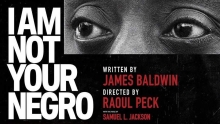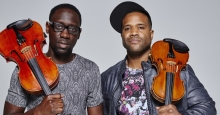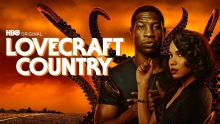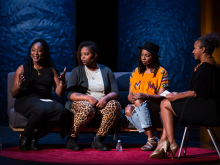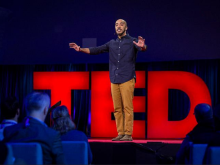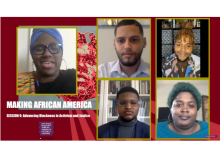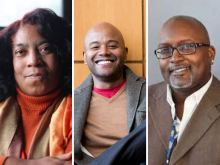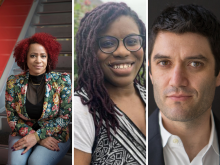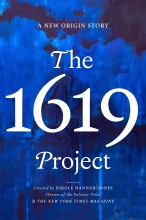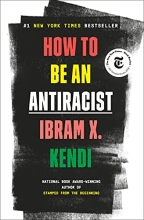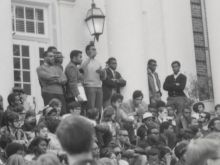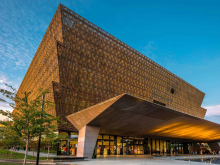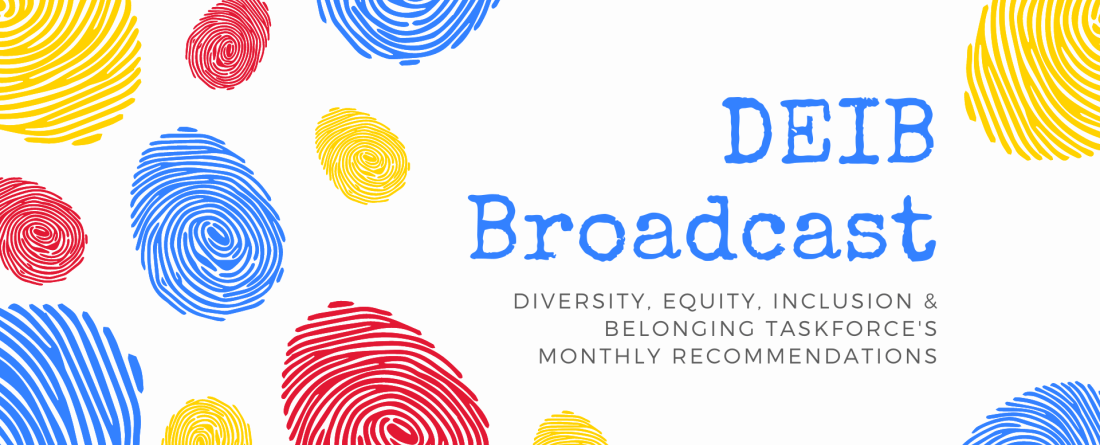
The School of Public Policy is committed to creating a thriving, inclusive environment at the School, where everyone takes an active role in incorporating diversity, inclusion and belonging into their work, classroom and interactions with students and colleagues. To that end, we’re excited to share our monthly recommendations for books, poetry, documentaries, podcasts, art and more for students to refer to on their personal and professional journeys to cultivating diversity, inclusion and belonging.
In the month of February we observe Black History Month, an annual celebration of achievements by African Americans and a time for recognizing their central role in U.S. history. To that end, here are a few recommendations from SPP staff, faculty, and members of the Diversity, Inclusion and Belonging Taskforce for you to engage with this month!
Watch
Civil rights leader and longtime US congressman John Lewis spent his life fighting for freedom and justice for everyone. In this illuminating conversation on the Fight for Civil Rights and Freedom with lawyer and activist Bryan Stevenson, Lewis discusses the essential importance of voting, shares encouraging words of wisdom for the generation of young people currently organizing in the struggle for racial justice and tells moving stories from his decades of making "good trouble" - at the Freedom Rides, March on Washington and in the halls of Congress. "When you see something that's not right or fair or just, you have to say something," Lewis says. "You have to do something."
Recommended by Dr. Alana Hackshaw!
“I Am Not Your Negro focuses on the unfinished manuscript of James Baldwin and his reflections around his friendships with Martin Luther King, Jr., Malcolm X, and Medgar Evers. The movie fuses elements about race relations in US society and the sociology of racism with the prophetic vision and writing of James Baldwin's about the civil rights movement. The documentary includes video footage and recordings of James Baldwin not previously seen before. And, the documentary is told entirely using James Baldwin's words. Peck brings together Baldwin's narratives with contemporary images that reinforce the ongoing significance of race and its damaging impact on society. I chose this documentary because it creates a visual and textual throughline between the US's unresolved past around racism and racial terror that continues to manifest in contemporary problems. It highlights that race has yet to be confronted, addressed, and understood by all Americans, in particular, white Americans. It is provocative and powerful how Peck uses imagery and language to capture the ongoing challenge of addressing our past and the consequences we face if we do not. It is currently showing on Netflix.” - Dr. Alana Hackshaw
Recommended by Dr. Alana Hackshaw!
“Black Violin is a musical duo of violinists, Wilner Baptiste (viola) and Kevin Sylvester (violin). They compose their own music including hip-hop music for string instruments. This duo travels around the US and visits the DMV quite often. Part of the goal of their work is to break down stereotypes by challenging the idea that classical music can only be played proficiently by non-Black people and that Black men should be best known only for their prowess in sports. They also seek to break the stereotype that classical music can only be produced from their instruments though they are classically trained.They share their love of these instruments with others but also to challenge notions that certain muscial genres and certain activities only "belong" to certain groups.” - Dr. Alana Hackshaw
Recommended by Dr. Alana Hackshaw!
“Lovecraft Country is a series on HBO based on the graphic novels of Matt Ruff which combines the sci-fi, horror, and fantasy genres into a coherent and epic tale that revolves around racism in the south during the Jim Crow era of the 1950s. Ruff's work adapts elements from the works of author H.P. Lovecraft, who was also a fantasy-horror writer from the early 20th century, to explore the connection between a Black family and White family who share a common ancestor but seek control over the power of that ancestor's legacy in their lives. The series directly addresses the ways that violence consistently shaped the experiences of Black Americans during the mid 20th century. The show's use of fantasy, sci-fi and horror captures the symbolism of racial terror's monstrosity as a historical and ongoing tool of power in US society.” - Dr. Alana Hackshaw
Recommended by Sahrah Marcellin!
“Viewers can gain a sense of why the importance of the Black Lives Matter movement with ideas and insight into how to be the best ally to help black people thrive. This interview with the founders of Black Lives Matter gives way to having a dialogue about social policy and the effects these policies have on minorities in America.” - Sahrah Marcellin
Recommended by Sahrah Marcellin!
“This recommendation is Clint Smith's TED Talk on How to raise a black son in America in which he poetically divulges into what it's like to live as a Black man in America as a child and young adult. He shares an anecdote from his interaction with his father as a child and also broadly discusses what he and other black men in America need to know for their survival. Smith expresses his desire for things to be different for all black men in America, especially for the sake of his son.” - Sahrah Marcellin
Preceded and influenced by the work and legacies of Claudia Jones, Shirley Chisholm, Maida Springer Kemp, Kwame Ture, and more, contemporary black immigrant organizers and advocates build on decades worth of political strategy and analysis to advance racial justice. This panel discussion on Advancing Blackness in Activism and Justice from the National Association for the Advancement of Colored People explores contemporary sites of and insights on mobilizing and advocacy, from the perspective of black immigrant organizers and advocates.
Giants of Racial Justice, an event from the Library of Congress celebrating African American History Month, features authors Peniel E. Joseph (“The Sword and the Shield”) and Tamara Payne (“The Dead Are Arising”) discussing their books on Malcolm X and Martin Luther King Jr. with NPR TV Critic Eric Deggans.
The 1619 Project began as a special edition of The New York Times Magazine, and is now a national cultural phenomenon that has generated a book, a podcast, a forthcoming documentary series, an illustrated children’s book and educational materials for schools. Creator Nikole Hannah-Jones and Donnalie Jamnah of the Pulitzer Center’s 1619 Education Network addressed questions on teaching “The 1619 Project,” answering questions like: How can teachers engage with this powerful material and share it with students? How should they respond to detractors’ calls to ban “The 1619 Project” and other subject matter that addresses the history of racial inequity and the Black experience in America? And how best can librarians and educators bring truthful representations of history to their students?
Read
The 1619 Project: A New Origin Story by Nikole Hannah-Jones offers a profoundly revealing vision of the American past and present. In late August 1619, a ship arrived in the British colony of Virginia bearing a cargo of twenty to thirty enslaved people from Africa. Their arrival led to the barbaric and unprecedented system of American chattel slavery that would last for the next 250 years. This is sometimes referred to as the country’s original sin, but it is more than that: It is the source of so much that still defines the United States.
The opposite of “racist” isn’t “not racist.” Ibram X. Kendi's book, How to Be an Antiracist, outlines the concept of antiracism, and reenergizes and reshapes the conversation about racial justice in America - but even more fundamentally, it points us toward liberating new ways of thinking about ourselves and each other. Instead of working with the policies and system we have in place, Kendi asks us to think about what an antiracist society might look like, and how we can play an active role in building it.
White people in North America live in a social environment that protects and insulates them from race-based stress. This insulated environment of racial protection builds white expectations for racial comfort while at the same time lowering the ability to tolerate racial stress. Racial stress results from an interruption to what is racially familiar. In turn, whites are often at a loss for how to respond in constructive ways., as we have not had to build the cognitive or affective skills or develop the stamina that would allow for constructive engagement across racial divides, leading to what Robin DiAngelo refers to as white fragility, the state in which even a minimum amount of racial stress becomes intolerable, triggering a range of defensive moves. White Fragility: Why It's So Hard for White People to Talk About Racism explicates the dynamics of white fragility and how white people might build their capacity in the on-going work towards racial justice.
Experience
The Claiming Their Space: Black Student Activism at the University of Maryland exhibit explores Black student activism at the University of Maryland, College Park (UMD) in the late 1960s, centering on several incidents in October 1968, including the rejection of appointments of radical Black students to the Committee of Meaningful Integration, the ice pelting incident at a home football game against the University of North Carolina, and the rejection of four unnamed Black women students from a home economics nutrition study. Collectively, these incidents culminated in a rally on October 22 at the Home Economics building, leading to the forming of the Black Student Union, which realigned their goals from mere integration to equality and Black student solidarity, reflecting national trends in the Black Power movement.
Why does Black History Month occur in February? How long has Black History Month been around? When did Black History Month come into being? Find the answers to these questions and more from the Association for the Study of African American Life and History’s website!
BlackPast is dedicated to providing a global audience with reliable and accurate information on the history of African America and of people of African ancestry around the world. BlackPast aims to promote greater understanding through this knowledge to generate constructive change in our society. Check out BlackPast’s reference center with 7,787 posts dedicated to providing information to the general public on African American history and the history of more than one billion people of African ancestry around the world.
The National Museum of African American History and Culture is the only national museum devoted exclusively to the documentation of African American life, history, and culture - and it’s just a hop, skip, and a jump away from UMD’s College Park campus! It was established by Act of Congress in 2003, following decades of efforts to promote and highlight the contributions of African Americans. To date, the Museum has collected more than 36,000 artifacts and nearly 100,000 individuals have become members.

